#Sound-from-PictureReality
Text
Sony TVs 2020 lineup at CES 2020 Review

As usual, the January CES in Las Vegas gathered a large number of experts. Traditionally, high-tech TVs have been the focus of attention. This year AI 8K upscaling in the Samsung Q950TS 8K and LG 8K TVs, bezel-less Infinity Design of Q950TS with a screen-to-body ratio of nearly 99% and super-thin LG Wallpaper series with a thickness under 4mm, improved game modes, sound control technologies, and adaptive options became the major innovative directions.
Of course, Sony also did not stand aside, introducing the new 8K LCD Z8H and 4K OLED A8H Master Series models.
As known, last year the company introduced the Master Series Z9G 8K, including 85-inch Sony XBR-85Z9G (KD-85ZG9) worth about $ 13,000 and the huge 98-inch XBR-98Z9G (KD-98ZG9) with a astronomical price of $ 70,000. However, today the cost of the Sony XBR-85Z9G has dropped to $ 10,000. In these models, the company used the new improved X1 Ultimate Proccesor together with the new 8K X-Reality PRO software technology.
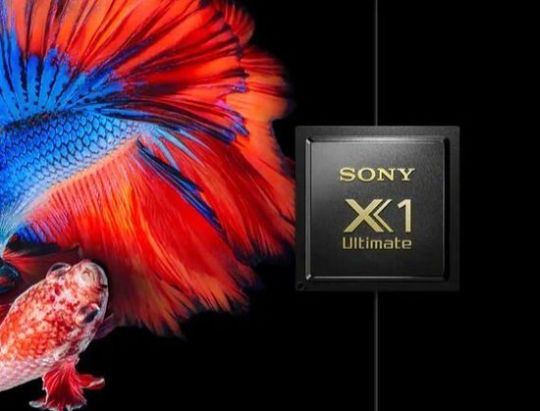
High 8K upscaling efficiency allowed the company to use them in new models of this year. As known, Sony upscaling algorithms use dual database processing. The first database recognizes compression noise, compares it with the reference image and eliminates artifacts. The second database increases resolution based on reference images.
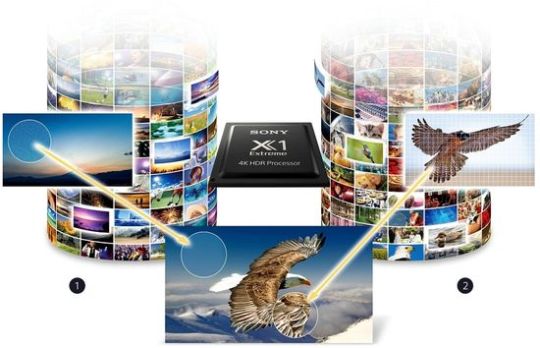
Design
8K LCD Z8H with an elegant silver rim looks very stylish.

The company named this unusual design an Immersive Edge concept. According to the designers, this design increases the immersion level and at the same time expand the functionality of the stand.
The name emphasizes the idea of enhancing immersion through an edge-oriented aesthetic. The minimalistic design with an ultra-narrow frame and an almost imperceptible stand minimize the visualization of the TV when watching. Together with Sound-from-Picture Reality, these two factors significantly raise the level of immersion.
As known, the company originally developed Acoustic Surface Audio for OLED models. Then based on it, Sony implemented Acoustic Multi-Audio in the ZG9 series. The technology uses four front-facing speakers, including two below the screen and two above it. This scheme effectively forms a surround sound. The company called this effect Sound-from-Picture Reality.
The adjustable legs radically simplified the installation of the TV. They can move from the edges of the screen to the center.
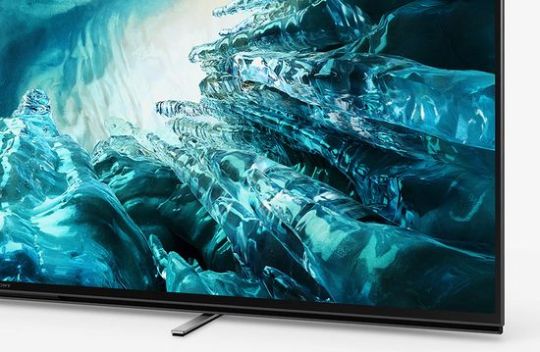
Moreover, the legs can rotate 90 degrees, providing a low-profile installation with virtually no clearance.

Unfortunately, the main competitors do not offer a similar option.
The 4K OLED A8H uses the One Slate design. It also has legs with adjustable height.

The choice of leg height varies up to 5-7 cm. This adjustment is very convenient, for example, when installing a TV in conjunction with a sound bar.
Ambient Optimization
The Sony Ambient Optimization feature fits perfectly into the overall trend of increasing the adaptability level of modern TVs. The company introduced it as “a new technology that optimises picture and sound quality in any customer environment.” For this purpose, the Samsung Q950TS 8K uses the Adaptive Picture function, and LG - new Dolby Vision IQ. The Ambient Optimization function automatically optimizes image parameters depending on the ambient light conditions.
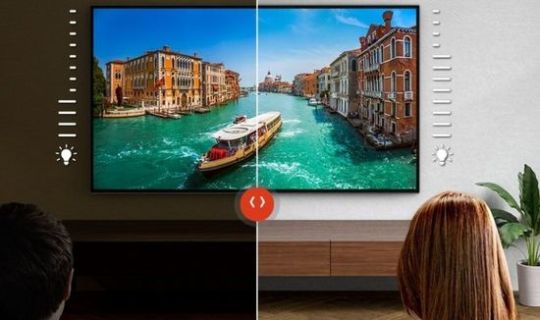
Of course, the work of Ambient Optimization is much more complicated than simply brightness increasing or decreasing in a dark or light room. In fact, it provides automatic adjustment of color gamma in the local areas of the screen. For example, for a bright room, the TV increases the brightness of the details in the shadows to improve their visibility. But at the same time, it does not change the brightness in bright areas of the frame to prevent glare. Moreover, the system increases the saturation of colors to eliminate the matting effect due to ambient light. Theoretically, Ambient Optimization will be especially effective for the HDR format.
Moreover, this technology detects surrounding objects, including curtains or furniture, and calibrates the acoustics settings to compensate for their effects on the propagation of sound waves.
X-Motion Clarity technology, Frame Tweeter and other
As known, modern TVs use the BFI function (Black Frame Insertion), which briefly turns off the backlight. Visually, this process is equivalent to a twofold increase in frame rate, which reduces blur in highly dynamic scenes. Unfortunately, BFI simultaneously reduces brightness. To solve this problem, Sony developed X-Motion Clarity technology, which replaced the previous Motionflow XR. In fact, X-Motion Clarity controls the transitions between frames, providing consistent brightness at high clarity and smoothness.
Initially, X-Motion Clarity Technology was developed for LCD televisions with FALD (full array local dimming). Today, the company has successfully adapted this technology for OLED models.
The Z8H series uses innovative Frame Tweeter technology, which transfers sound vibrations to the TV frame, turning it into a sound source.
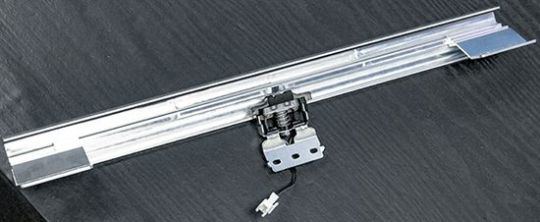
In addition, new TVs support Netflix Calibrated Mode, IMAX Enhanced, Dolby Atmos and Sony’s Acoustic Surface Audio+ with a subwoofer behind the screen and two actuators to vibrate the display.

Unfortunately, unlike the Sony 8K Z8H, the A8H does not have HDMI 2.1.
Key Features
BRAVIA 8K HDR Z8H series
It includes 75- and 85-inch TVs with Full Array LED backlight.
Key Features:
- ultra-high contrast with 8K resolution;
- HDMI 2.1;
- peak brightness exceeds 1000 nits;
- X1Ultimate processor with 8K X-RealityPRO technology (8K upscaling);
- Frame Tweeter + Sound-from-Picture Reality;
- adjustable stand;
- HDR10, Dolby Vision and HLG support;
- Ambient Optimization;
- compatible with Dolby Vision and Dolby Atmos;
- voice control;
- support for Apple AirPlay 2, HomeKit and Amazon Alexa;
- Android 9 Pie;
- support for 4K @ 120fps.
4K HDR OLED A8H series
It includes 55- and 65-inch XBR55A8H and XBR65A8H TVs
Key Features:
- X1Ultimate processor;
- Pixel Contrast Booster;
- X-Motion Clarity;
- Acoustic Surface Audio + two subwoofers;
- Ambient Optimization;
- compatible with Dolby Vision and Dolby Atmos;
- support for Apple AirPlay 2, HomeKit and Amazon Alexa;
- Android 9 Pie.
In addition, the company expanded last year’s super-popular A9G series with the addition of a 48-inch XBR-48A9G. As known, LG this year also offered a 48-inch LG OLED48CXPUA. Apparently, the main manufacturers of OLED TVs are planning to expand their lineup with low-cost models with a relatively small screen. Of course, many consumers will welcome the new offer.
Conclusion
Once again, the company fully met the expectations of Sony fans. In fact, the Sony 2020 lineup contains a complete list of current TVs, including LCD and OLED models with 4K and 8K resolution. In addition, the company demonstrated its commitment to the innovation trend by introducing new Ambient Optimization mode, X-Motion Clarity for OLED, and promising Frame Tweeter technology.
Of course, Samsung, LG and other leaders in this segment also presented a large number of interesting innovative models. But the results of their competition will depend on the pricing policy of companies, which will be determined in the next few months.
Video demonstrates Sony BRAVIA Z8H series at CES 2020.
Read the full article
#AcousticMulti-Audio#AcousticSurfaceAudio#AmbientOptimization#FrameTweeter#ImmersiveEdgedesign#OneSlatedesign#SonyKD-75ZH8#SonyKD-85ZH8#SonyTVs2020#SonyXBR75Z8H#SonyXBR85Z8H#SonyXBR55A8H#SonyXBR65A8H#Sound-from-PictureReality#XBR-48A9G
0 notes
Text
Review of Sony 8K TVs

For several decades now, fierce competition and digital technologies stimulate innovative boom in the consumer electronics segment, including high-tech TVs. HDR technology, HDMI 2.1 standard, 10 and 12-bit color depth, HFR (high frame rate) format, Micro LED, etc perfectly illustrate this trend.
Of course, increasing the TV resolution is one of the main directions. More recently, experts argued about the prospects for the development of 4K resolution and HDR format due to a clear deficit of the corresponding native HDR content. As known, this factor has become crucial for 3D. In fact, almost all market leaders have abandoned this option in their models due to the limited 3D content.
But fierce competition forces companies to take risks. As a result, most of the major market participants are developing support for the HDR format and increasing resolution, despite the uncertainty in the content production segment. Therefore, modern models of almost all well-known manufacturers support the HDR format (HDR 10, HDR 10+, HLG standards and even Dolby Vision in top-models). Moreover, many companies have already introduced their 8K TVs. For example, the market today already offers LG 8K TVs (OLED88Z9 and Nanocell 75SM9970), Samsung 8K TVs (Q900R series), etc.
Sony's strategy is fully in line with this trend. At CES 2019, the company introduced the Master Series ZG9 with 8K resolution.

Sony 8K Master Series
As known, the effect of resolution on image quality is maximally manifested on large screens. For example, for TVs up to 50 inches most people are unlikely to feel the difference between HD and 4K resolution. Therefore, the diagonal of modern 8K models varies from 65 to 98 inches. Of course, their cost is very high. For example, the price of 88-inch LG OLED88Z9 reaches $ 30,000, and 75-inch LG Nanocell 75SM9970 costs about $ 5,000. Today, only Samsung offers the 55-inch QN55Q900RBFXZA 8K model for about $ 2,000. Of course, time will show the prospects of 8K models with a relatively small diagonal.
In this aspect, Sony strategy consistent with the overall trend. Therefore, the Master Series Z9G includes 85-inch Sony XBR-85Z9G (KD-85ZG9) worth about $ 13,000 and the huge 98-inch XBR-98Z9G (KD-98ZG9) with a price of $ 70,000.
Their support HDR10, Dolby Vision, and HLG standards of HDR format.
Z9G has new MediaTek SoC (MT5893) processor. MediaTek 5893 uses the relatively new Cortex A73 cores, delivering better performance compared to SoC in 2018 models. In addition, its RAM reaches of 2.5 GB.
Moreover, TV uses the new improved X1 Ultimate video chip.

It works on the basis of a unique algorithm, providing processing for 33 million pixels (7680 x 4320 resolution). In addition, the chipset, together with the new 8K X-Reality PRO software technology, effectively scales any content.
Unfortunately, MediaTek SoC does not support 8K HEVC or VP9-2 decoding. In addition, 8K playback from YouTube requires an external player with HDMI 2.1.
Sony's technologies
Traditionally, the company uses many innovative technologies in the Master Series TVs. This list includes:
- Backlight Master Drive technology uses ultra-dense LED modules with individual control. It provides maximum contrast throughout the screen, given the frame brightness;
- Object-based Super Resolution recognizes individual objects, increasing their resolution during playback;
- Dual database processing increases correction performance, reducing processing time. The first database lowers the noise level, and the second database increases the image clarity due to resolution increase with software;
- Object-based HDR remaster analyzes the colors of objects in the image and adjusts their contrast;
- Super Bit Mapping HDR prevents image segmentation and creates a realistic image on the screen;
- 8K X-tended Dynamic Range PRO optimally distributes the backlight, creating a contrast image with an increased level of brightness. In addition, the technology improves image resolution from any source to HDR+ quality standard;

- X-Motion Clarity delivers crisp, smooth playback of highly dynamic scenes without compromising image brightness.

- Motionflow XR creates additional interpolation frames between the original image frames, ensuring smooth playback of highly dynamic scenes. Almost all the latest Sony BRAVIA provide a screen refresh rate of up to 1000 Hz;
- X-Wide Angle technology provides natural colors when viewing at any angle with an additional filter that reduces color shift in this case. Unfortunately, it slightly reduces natural contrast.

- 8K X-Reality Pro with X1 Ultimate provide high-quality upscaling;

Other features
TRILUMINOS Display in combination with Live Color technology enhances brightness and color accuracy.

ClearAudio+ optimizes TV sound with four algorithms of automatically adjusting for different types of images, increasing perception realism.
S-Force Front Surround provides surround sound. The system provides emulation of a 3D sound field without using an additional speaker system.
Acoustic Surface Audio+ technology directs sound through the screen surface. For example, the OLED AF9 uses three power drives on the rear panel to transmit vibration to the screen. In addition, it has two subwoofers for low frequencies. This technology provides deeper and surround sound reproduction and perfect synchronization of the audio track with the image. The company called this technology Sound-from-Picture Reality.

Z9G runs on Android 8.0 (Oreo) with access to HBO, Netflix and YouTube. Unfortunately, the company has not updated the user Android TV interface for 8K resolution.
Sony 8K TVs support Dolby Atmos, Chromecast, AirPlay 2 (wireless transfer of multimedia content to TV), HomeKit, and Hands-free voice control.

Image quality
Of course, superb detailing, colors saturation and color accuracy give an indelible impression, creating a strikingly realistic picture. But, unfortunately, the assessment of image quality is not very relevant due to the acute shortage of native 8K content. Probably, efficiency of 8K upscaling will be more appropriate rating criteria of modern 8K TVs, because in the coming years they will mainly perform this function.
As known, Z9G uses for this purpose X1 Ultimate, which the company previously installed on 4K premium models. In addition, Sony has been successfully using object analysis for many years, which is based on the detection of objects in an image, for example, on a face, apple or flower. Of course, scaling systems do not add additional details when processing in real time. In other words, they add artificial sharpness around objects, but does not do real pixel recalculation.
In fact, engineers are trying to achieve visualization of the quality difference between 4K and 8K. But native 4K content today is superbly detailed even for an 85-inch screen. Therefore, engineers have to surpass their own great results. The eye of most people is unlikely to capture image differences between Sony 4K TV and ZG9.
Conclusion
Pros
- incredibly detailed and bright native 8K pictures;
- exellent video processing;
- an unusually wide viewing angle;
- еxcellent motion;
- very good sound;
- еxcellent upscaled sub-8K pictures.
Cons
- no native 8K content;
- very high price;
- just one HDMI 2.1 capable port;
- black could be deeper.
Of course, the appropriateness of buying expensive innovative models is always a dubious choice for many consumers. On the one hand, over the next few years, the processors of 8K models will mainly scale Full HD and 4K formats to 8K due to a shortage of 8K content.
On the other hand, some 8K TVs are already available to many fans of innovative devices with a good budget.
The traditional comparison of models in terms of price / quality ratio is premature, because the market has not yet formed due to limited supply.
This video contains an overview of the Sony BRAVIA Z9G / ZG9 Master Series 8K HDR TV.
Read the full article
#8KX-tendedDynamicRangePRO#BacklightMasterDrive#ClearAudio+#Dualdatabaseprocessing#LGNanocell75SM9970#MediaTek5893#MediaTekSoC#Object-basedSuperResolution#S-ForceFrontSurround#SamsungQ900Rseries#Sony8KTVs#SonyBRAVIAMasterSeries8KHDRTV#SonyKD-85ZG9#SonyKD-98ZG9#SonyXBR-85Z9G#SonyXBR-98Z9G#Sound-from-PictureReality#SuperBitMappingHDR#X1Ultimate
0 notes